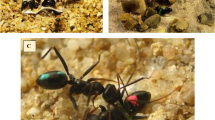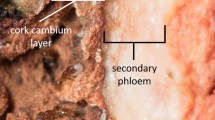Abstract
Anting is the application of ants or “substitutes” of ants by birds to their plumage. The earliest scientific reports concerning this behavior appeared in the early 19th century, but the targeted collection of facts began in the late 1930s. As a result, anting has been recorded (in nature or/and in captivity) on all but one continent for more than 200 bird species of several orders, mostly passerines. “Active” and “passive” antings are usually recognized as the two main types of this procedure. In the active procedure, birds take ants with their bill and directly smear their feathers. Other manifold (several dozen variants) living and nonliving objects are also used for active anting. The birds practicing passive anting visit ant colonies, provoke ants to attack, and allow them to pass through their plumage. For a given type of anting, the procedure consists of stereotypic movements and postures. Ants belonging to the subfamily Formicinae (mostly Formica, Lasius, and Camponotus), which spray or exude formic acid in attack and defense, are predominantly used, whereas Dolichoderinae and Myrmicinae take second and third places, respectively. Although anting can be studied by manipulative experiments with captive birds, the functions of this behavior remain unclear. It has been suggested that anting acts as way of (1) ridding of ectoparasites, (2) feather grooming, (3) decreasing skin irritation during molt, (4) food preparation (removing pungent effluents from ant bodies before eating them), (5) sensory self-stimulation, etc. However, convincing support for any of the hypotheses is still absent.
Similar content being viewed by others
References
Adlersparre, A., Zum Thema “Vogel und Ameisen,” Ornithol. Monatsber., 1936, vol. 44, pp. 129–135.
Ali, S., Do birds employ ants to rid themselves of ectoparasites? J. Bombay Nat. Hist. Soc., 1936, vol. 38, no. 3, pp. 628–631.
Anglo-russkii biologicheskii slovar’ (English-Russian Biological Dictionary), Chibisova, O.I., Ed., Moscow: Russkii Yazyk, 1993, 5th ed. Anting activity. http://www.youtube.com/watch?v=b8ldqV47i0
Audubon, J.J., Ornithological Biography, or an Account of the Habits of the Birds of the United States of America; Accompanied by Descriptions of the Objects Represented in the Work Entitled “The Birds of America, and Interspersed with Delineations of American Scenery and Manners,” Philadelphia: E.L. Carey and A. Hart, 1831, vol. 1.
Baker, M., Fur rubbing: use of medicinal plants by capuchin monkeys (Cebus capucinus), Am. J. Primatol., 1996, vol. 38, no. 3, pp. 263–270.
Blum, M.S., Ant venoms: chemical and pharmacological properties, J. Toxicol. Toxin Rev., 1992, vol. 11, no. 2, pp. 115–164.
Brackbill, H., Anting by four species of birds, Auk, 1948, vol. 65, no. 1, pp. 66–77.
Braekman, J.C. and Daloze, D., Defensive alkaloids from ants, J. Braz. Chem. Soc., 1996, vol. 7, no. 4, pp. 251–256.
Carroll, J.F., Kramer, M., Weldon, P.J., and Robbins, R.G., Anointing chemicals and ectoparasites: effects of benzoquinones from millipedes on the Lone Star Tick, Amblyomma americanum, J. Chem. Ecol., 2005, vol. 31, no. 1, pp. 63–75.
Chisholm, A.H., Bird Wonders of Australia, Sydney: Angus and Robertson, 1934.
Chisholm, A.H., The problem of “anting,” Ibis, 1944, vol. 86, no. 3, pp. 389–405.
Clark, C.C., Clark, L., and Clark, L., “Anting” behavior by common grackles and European starlings, Wilson Bull., 1990, vol. 102, no. 1, pp. 167–169.
Clayton, D.H., Koop, J.A.H., Harbison, C.W., et al., How birds combat ectoparasites? Open Ornithol. J., 2010, vol. 3, pp. 41–71.
Craig, A.J.F.K., Anting in Afrotropical birds: a review, Ostrich, 1999, vol. 70, nos. 3–4, pp. 203–207.
Crow anting. http://www.youtube.com/watch?v=IcRgjUaK4RA
Dlussky, G.M., Murav’I roda formika (Hymenoptera, Formicidae, g. Formica) (The Ants of Genus Formica (Hymenoptera, Formicidae, g. Formica)), Moscow: Nauka, 1967.
Dlussky, G.M., Murav’i pustyn’ (The Desert Ants), Moscow: Nauka, 1981.
Douglas, H.D. III, Malenke, J.R., and Clayton, D.H., Is the citrus-like plumage odorant of crested auklets (Aethia cristatella) a defense against lice? J. Ornithol., 2005, vol. 146, no. 2, pp. 111–115.
Dubinin, V.B., Feather mites (Analgesoidea). Part 1. Introduction, in Fauna SSSR. Paukoobraznye (Fauna of the Soviet Union: Arachnids), Moscow: Akad. Nauk SSSR, 1951, vol. 6, no. 5.
Dubinin, V.B., Feather mites (Analgesoidea). Part 3. Family Pterolichidae, in Fauna SSSR. Paukoobraznye (Fauna of the Soviet Union: Arachnids), Moscow: Akad. Nauk SSSR, 1956, vol. 6, no. 7.
EcoBirds, Anting. http://birds.ecoport.org/Behaviour/EBanting.htm
Ehrlich, P.R., Dobkin, D.S., and Wheye, D., The adaptive significance of anting, Auk, 1986, vol. 103, no. 4, p. 835.
Eisner, T. and Aneshansley, D., “Anting” in blue jays: evidence in support of a food-preparatory function, Chemoecology, 2008, vol. 18, no. 4, pp. 197–203.
Falótico, T., Labruna, M.B., Verderane, M.P., et al., Repellent efficacy of formic acid and the abdominal secretion of Carpenter ants (Hymenoptera: Formicidae) against Amblyomma ticks (Acari: Ixodidae), J. Med. Entomol., 2007, vol. 44, no. 4, pp. 718–721.
Formozov, A.N., Zveri, ptitsy i ikh vzaimosvyazi so sredoi obitaniya (Animals, Birds, and Their Relationships with Environment), Moscow: Nauka, 1976.
Fushihara, H., Anting by the Japanese grey thrush, Turdus cardis cardis Temminck, Tori, 1959, vol. 15, no. 72, pp. 61–70.
Goodwin, D., Some aspects of the behavior of the jay Garrulus glandarius, Ibis, 1951, vol. 93, no. 4, pp. 602–625.
Goodwin, D., Interspecific differences in the anting movements of some corvine birds, Ibis, 1953, vol. 95, no. 1, pp. 147–149.
Gosse, P.H., Birds of Jamaica, London: Paternoster Row, 1847.
Groff, M.E. and Brackbill, H., Purple grackles “anting” with walnut juice, Auk, 1946, vol. 63, no. 2, pp. 246–247.
Groskin, H., Scarlet Tanagers “anting”, Auk, 1943, vol. 60, no. 1, pp. 55–59.
Groskin, H., Additional observations and comments on “anting” by birds, Auk, 1950, vol. 67, no. 2, pp. 201–209.
Harwin, R.M., Anting, Rhodesian Ornithol. Soc. Bull., 1959, no. 28, p. 4.
Hauser, D.C., Comparison of anting records from two localities in North Carolina, Chat, 1973, vol. 37, no. 4, pp. 91–102.
Heine, H., Krähen benützen Ameisen zum Vertreiben von Auszenparasiten, Ornithol. Monatsber., 1929, vol. 37, no. 6, pp. 188–189.
Hölldobler, B. and Wilson, E.O., The Ants, Cambridge, MA: Belknap Press, 1990.
http://www.youtube.com/watch?v=LoDvLsk6C5g,NR=1, feature=endscreen
http://www.youtube.com/watch?v=SJaiHorf8qI
http://www.youtube.com/watch?v=w4VMuJVrrIM
Ivor, H.R., Further studies of anting by birds, Auk, 1943, vol. 60, no. 1, pp. 51–55.
Ivor, H.R., The enigma of bird anting, Natl. Geogr., 1956, vol. 110, pp. 105–119.
Jay being attacked by ants 29/07/10–Anting. http://www.youtube.com/watch?v=314-HtWIOps
Jefferson, J.P., Tapanes, E., and Evans, S., Owl monkeys (Aotus spp.) perform self- and social anointing in captivity, Folia Primatol., 2014, vol. 85, no. 2, pp. 119–134.
Judson, O.P. and Bennett, A.T.D., Anting as food preparation: formic acid is worse on an empty stomach, Behav. Ecol. Soc., 1992, vol. 31, no. 6, pp. 437–439.
Kelso, L. and Nice, M.M., A Russian contribution to anting and feather mites, Wilson Bull., 1963, vol. 75, no. 1, pp. 23–26.
Kugler, C., Evolution of the sting apparatus in the myrmicine ants, Evolution, 1979, vol. 33, no. 1, pp. 117–130.
Leca, J.-B., Gunst, N., and Petit, O., Social aspects of furrubbing in Cebus capucinus and C. paella, Int. J. of Primatol., 2007, vol. 28, no. 4, pp. 801–817.
Löhrl, H., Das Ameisenbad der Vögel, Kosmos, 1956, vol. 52, no. 6, pp. 271–274.
Lunt, N., Hulley, P.E., and Craig, A.J.F.K., Active anting in captive cape white-eyes Zosterops pallidus, Ibis, 2004, vol. 146, no. 2, pp. 360–362.
Lynch Alfaro, J.W., Matthews, L., Boyette, A.H., et al., Anointing variation across wild capuchin populations: a review of material preferences, bout frequency and anointing sociality in Cebus and Sapajus, Am. J. Primatol., 2012, vol. 74, no. 4, pp. 299–314.
Monkey medicine at living links in Edinburgh Zoo. http://www.youtube.com/watch?v=I5TDlG441gA
McAtee, W.L., Anting by birds, Auk, 1938, vol. 55, no. 1, pp. 98–105.
Meunier, H., Petit, O., and Deneubourg, J.-L., Resource influence on the form of fur rubbing behavior in white faced capuchins, Behav. Process., 2008, vol. 77, no. 3, pp. 320–326.
Miller, F.W., Blue jay, Cyanocitta cristata, “anting” with burning cigarettes, Auk, 1952, vol. 69, no. 1, pp. 87–88.
Morozov, N.S., A bird in the anthill, Priroda, 2014, no. 7, pp. 43–48.
Moyer, B.R. and Clayton, D.H., Avian defenses against ectoparasites, in Insect and Bird Interactions, van Emden, H.F. and Rothschild, M., Eds., Andover, UK: Intercept, 2004, pp. 243–259.
Nice, M.M., Blue jay anting with hot chocolate and soap suds, Wilson Bull., 1955, vol. 67, no. 1, p. 64.
Parkes, K.C., Weldon, P.J., and Hoffman, R.L., Polydesmidan millipede used in self-anointing by a strong-billed woodcreeper (Xiphocolaptes promeropirhyncus) from Belize, Ornitol. Neotrop., 2003, vol. 14, no. 2, pp. 285–286.
Post, W. and Browne, M.M., Active anting by the Yellow-shouldered Blackbird, Wilson Bull., 1982, vol. 94, no. 1, pp. 89–90.
Potter, E.F. and Hauser, D.C., Relationship of anting and sunbathing to molting in wild birds, Auk, 1974, vol. 91, no. 3, pp. 537–563.
Poulsen, H., A study of anting behavior in birds, Dansk Ornithol. For. Tidsskr., 1956, vol. 50, no. 4, pp. 267–298.
Querengässer, A., Über das Einemsen von Singvögeln und die Reifung dieses Verhaltens, J. Ornithol., 1973, vol. 114, no. 1, pp. 96–117.
Revis, H.C. and Waller, D.A., Bactericidal and fungicidal activity of ant chemicals on feather parasites: an evaluation of anting behavior as a method of self-medication in songbirds, Auk, 2004, vol. 121, no. 4, pp. 1262–1268.
Reymond, E., Myrmécophilie chez la Perdix bartavelle, Nos Oiseaux, 1948, vol. 19, p. 288.
Sekulić, T.Lj., Vujisić, Lj.V., Ćurčić, B.P.M., et al., Quinones and non-quinones from the defensive secretion of Unciger transsilvanicus (Verhoeff, 1899) (Diplopoda, Julida, Julidae), from Serbia, Arch. Biol. Sci., Belgrade, 2014, vol. 66, no. 1, pp. 385–390.
Shul’pin, L.M., Promyslovye, okhotnich’i i khishchnye ptitsy Primor’ya (Commercial, Hunting, and Raptorial Birds in Primorye), Vladivostok: Dal’nevost. Fil., Akad. Nauk SSSR, 1936.
Sick, H., Anting by two tanagers in Brazil, Wilson Bull., 1957, vol. 69, no. 2, pp. 187–188.
Simmons, K.E.L., A review of the anting-behavior of passerine birds, Br. Birds, 1957, vol. 50, no. 10, pp. 401–424.
Simmons, K.E.L., Anting and the problem of self-stimulation, J. Zool., 1966, vol. 149, part 2, pp. 145–162.
Simmons, K.E.L., Anting, in A Dictionary of Birds, Campbell, B. and Lack, E., Eds., Vermillion, South Dakota: Buteo Books, 1985, p. 19.
Smirnov, N.N., Panov, E.N., and Mikheev, V.N., Russkoangliiskii i anglo-russkii slovar’ po ekologii, etologii i okhotovedeniyu (Russian-English and English-Russian Dictionary of Ecological, Ethological, and Hunting Terms), Moscow: Librokom, 2014.
Strange behavior in grackles. http://www.youtube.com/watch?v=yfQbqyYXHjo
Stresemann, E., Werden Ameisen durch Vögel zum Vertreiben von Aussenparasiten benützt? Ornithol. Monatsber., 1935a, vol. 43, no. 4, pp. 114–115.
Stresemann, E., Die Benutzüng von Ameisen zur Gefiederpflege, Ornithol. Monatsber., 1935b, vol. 43, no. 5, pp. 134–138.
The anting, tingling or bathing of ants by the birds. http://www.youtube.com/watch?v=98_UlErwM5Y
Thomas, J.W., Anting performed by scaled quail, Wilson Bull., 1957, vol. 69, no. 3, p. 280.
Torres, A.F.C., Quinet, Y.P., Havt, A., et al., Molecular pharmacology and toxicology of venom from ants, in An Integrated View of the Molecular Recognition and Toxicology—from Analytical Procedures to Biomedical Applications, Rádis-Baptista, G., Ed., InTech, 2013, pp. 207–222.
Valderrama, X., Robinson, J.G., Attygalle, A.B., and Eisner, T., Seasonal anointment with millipedes in a wild primate: a chemical defense against insects?, J. Chem. Ecol., 2000, vol. 26, no. 12, pp. 2781–2790.
Weldon, P.J. and Carroll, J.F., Vertebrate chemical defense: secreted and topically acquired deterrents of arthropods, in Insect Repellents: Principles, Methods, and Uses, Debboun, M., Frances, S.P., and Strickman, D., Eds., Boca Raton: CRC Press, 2006, pp. 47–76.
Whitaker, L.M., A résumé of anting, with particular reference to a captive Orchard Oriole, Wilson Bull., 1957, vol. 69, no. 3, pp. 195–262.
Wiles, G.J. and McAllister, K.R., Records of anting by birds in Washington and Oregon, Wash. Birds, 2011, vol. 11, pp. 28–34.
Zakharov, A.A., Muravei, sem’ya, koloniya (The Ant, Family, and Colony), Moscow: Nauka, 1978.
Zakharov, A.A., The ants: life in the forest, in XX Chteniya pamyati V.N. Sukacheva “Nasekomye v lesnykh biogeotsenozakh” (The XX Conf. Dedicated to the Memory of V.N. Sukachev “Insects in Forest Biogeocenosises”), Chernov, Yu.I., Ed., Moscow: KMK, 2004, pp. 54–82.
Author information
Authors and Affiliations
Corresponding author
Additional information
Original Russian Text © N.S. Morozov, 2015, published in Uspekhi Sovremennoi Biologii, 2015, Vol. 135, No. 1, pp. 97–112.




